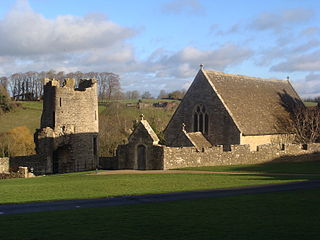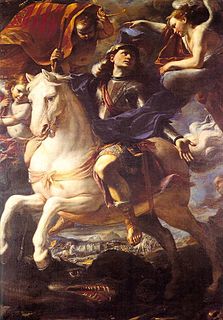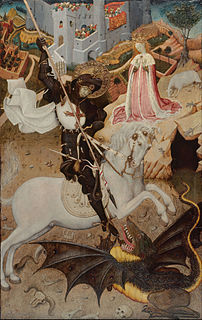 W
WSaint George and the Dragon is a mural in the chapel of Farleigh Hungerford Castle, Somerset, England.
 W
WThe 1472 Altarpiece was a tempera and oil on panel altarpiece by Carlo Crivelli, dated 1472 on the central panel. Also known as the Fesch Altarpiece or the Eckinson Altarpiece, it is now divided up between a number of galleries in the United States and Europe.
 W
WAdoration of the Christ Child is a tempera on panel altarpiece by Filippo Lippi, originally painted for the church of San Domenico in Prato and now in the city's Museo Civico. It is also known as Adoration of the Christ Child with St Vincent Ferrer or Nativity with St George and St Vincent Ferrer. It was painted between 1455 and 1466. The work was probably damaged by a fire in the church in 1467, requiring some repairs which were discovered in a recent restoration of the work.
 W
WThe Archers' Guild Altarpiece is a c.1590 painting by Maerten de Vos, now in the Royal Museum of Fine Arts Antwerp. Around 1585 Alessandro Farnese succeeded in reintroducing Catholicism to the Southern Netherlands. Partly because he was in favour of guild altars, the Oude Voetboog archers' guild in Antwerp commissioned the work from de Vos.
 W
WMadonna of the Swallow is a painting by Carlo Crivelli. It is named after the swallow perched on the top left hand corner of the Madonna's throne - the bird was a symbol of the Resurrection. It was commissioned by Ranuzio Ottoni and Giorgio di Giacomo for the church of San Francesco in Matelica in March 1490 - Ottoni was Lord of Matelica and Giacomo was guardian of the local Franciscan monastery. It was completed between 1490 and 1492. It is now in the National Gallery, London, who bought it in 1862.
 W
WThe Porto San Giorgio Altarpiece or Porto San Giorgio Polytpych was a 1470 multi-panel tempera and gold on panel altarpiece by Carlo Crivelli. Stylistically similar to Crivelli's Massa Fermana Altarpiece, the work was a fundamental step in his evolution away from the Paduan Renaissance towards a more delicate and realist style.
 W
WThe Ferrara Cathedral Organ Case was a set of 1469 tempera on canvas paintings by Cosme Tura, originally forming doors for the organ at Ferrara Cathedral but now in the cathedral museum. Originally double-sided, the front and back of each door have now been separated. As originally constructed, the doors showed an annunciation scene when open and Saint George and the Princess when closed.
 W
WMadonna and Child with Saint George is an oil on panel painting by Correggio dating to around 1530 and now in the Gemäldegalerie in Dresden.
 W
WMadonna and Child with Two Saints or Madonna and Child with Saint Anthony Abbot and Saint George is a panel painting by Pisanello, executed c. 1445, now in the National Gallery, London. It is his only signed panel work ("Pisanus").
 W
WThe Madonna della Vittoria is a painting by the Italian Renaissance painter Andrea Mantegna; the painting was executed in 1496.
 W
WThe Martyrdom of Saint George is a 1566 oil on canvas painting by Paolo Veronese, produced for the high altar of the church of San Giorgio in Braida in Verona, dedicated to saint George, where it still hangs. It was produced in Verona, the artist's birthplace, whilst he was back there to marry Elena, daughter of his teacher Antonio Badile.
 W
WThe Paumgartner altarpiece is an early triptych painting by Albrecht Dürer, commissioned by the Paumgartner family of Nuremberg. The central panel depicts a nativity scene, while the wings depict Saint George (left) and Saint Eustace (right). The saint's faces are donor portraits of the brothers Stephan and Lukas Paumgartner, respectively. Other members of the Paumgartner family are depicted as small figures in the center panel.
 W
WSaint George on Horseback is an oil painting by Mattia Preti painted in 1658. It is the altarpiece of the Chapel of the Langue of Aragon in St. John's Co-Cathedral, Valletta, Malta. The painting was Preti's first work in Malta, and it is regarded as one of his masterpieces and one of the best examples of Neapolitan Baroque art.
 W
WSt. George and the Dragon is a small oil on wood cabinet painting by the Italian High Renaissance artist Raphael, painted c. 1505, and now in the National Gallery of Art in Washington, D.C. The saint wears the blue garter of the English Order of the Garter, reflecting the award of this decoration in 1504 to Raphael's patron Guidobaldo da Montefeltro, Duke of Urbino, by King Henry VII of England. The first word of the order's motto, "HONI" can be made out. The painting was presumably commissioned by the Duke, either to present to the English emissary who brought the regalia to Urbino, Sir Gilbert Talbot, or to Henry himself—recent scholarship suggests the latter. The honour paid to a minor Italian ruler reflected Henry's appreciation of the cultural prestige of Renaissance Italy as much as any diplomatic purpose.
 W
WSt. George or St. George and the Dragon is a small painting by the Italian Renaissance artist Raphael, executed c. 1503-1505. It is housed in the Louvre in Paris. A later version of the same subject is the St. George in the National Gallery of Art in Washington, D.C.
 W
WThe Roverella Altarpiece was a religious painting by Cosmè Tura completed during 1470–1474 using oil and egg-tempera on poplar panel work, commissioned by abbot and cardinal Bartolomeo Roverella for San Giorgio fuori le mura in Ferrara in memory of his brother bishop Lorenzo Roverella. It was one of the most significant works of the artist and of the Ferrara Renaissance in general. It was damaged in an explosion in 1709 and moved out of the church. It is now dismembered and their panels split up between several museums.
 W
WSaint George and the Princess is a late 15th century tempera on panel painting, attributed to Antonio Cicognara and now in the Pinacoteca Tosio Martinengo in Brescia.
 W
WSaint George Killing the Dragon, also known as Saint George and the Dragon is a tempera painting by the Spanish artist Bernat Martorell, painted c. 1434 – c. 1435. It depicts the famous legend of St. George and the Dragon in which the Christian knight, St. George, rescues a princess from a dragon.
 W
WIl Tramonto is an oil on canvas landscape painting by Giorgione, created c. 1505-1508, now in the National Gallery, London, which bought it in 1961.
 W
WThe Virgin and Child with Saints Dorothy and George is a c.1516 oil on panel painting by Titian, now in the Prado Museum in Madrid, to which it was transferred in 1839.